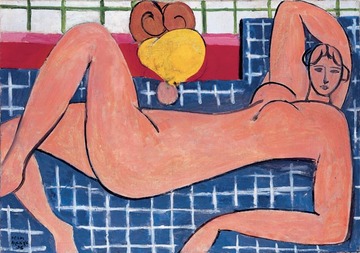I’ve sometimes wondered here whether viewing art online will lead people to visit museums, but I’ve not thought much about whether viewing art at museums will lead people to their website for more about the art they’ve just seen. I did praise The Mourners’ website (here), and a few others, but that was about it.
I certainly don’t recall visiting an exhibition and then going home eager to see what’s online about the show — until today. I was up at the Jewish Museum* to see Collecting Matisse and Modern Masters: The Cone Sisters of Baltimore. It’s drawn from the renowned, and large, Cone Collection of modern art that is the jewel of the Baltimore Museum of Art.
 On display in the Jewish Museum’s last gallery of the show is Matisse’s Large Reclining Nude, which he painted in 1935, devising the design over five months, photographing his variations, and sending 22 photos to Etta Cone in hopes that she would buy the work, a tactic that worked. Near the picture, the Jewish Museum has posted small version of six of the 22 photos — and a note that the entire set is available on line.
On display in the Jewish Museum’s last gallery of the show is Matisse’s Large Reclining Nude, which he painted in 1935, devising the design over five months, photographing his variations, and sending 22 photos to Etta Cone in hopes that she would buy the work, a tactic that worked. Near the picture, the Jewish Museum has posted small version of six of the 22 photos — and a note that the entire set is available on line.
Hence my post-visit log on, where I was pleased to find the aforementioned photos and much more — under a tab for the exhibition called “Look Closer.” For a start, here you can get a look at all 22, along with a podcast of the audioguide spot museum-goers hear (plus a transcript).
But the images are tiny, and I was about to turn away in disappointment when I noticed tabs on the bottom of that page: “All Images,” where they parade across your screen; “Figure,” which displays only the photos in which Matisse is working out the figure form; “Room,” ditto for the space; “Patterns,” likewise for the furnishings; and “Process,” which outlines how Matisse worked as he made changes (e.g., he attached paper in some cases, experimenting with changes before painting them). Each of those categories is accompanied by a podcast and transcript not available on the museum audioguide.
I found this fascinating — a very good reason to go home and look at what’s on a museum’s website (assuming it informs visitors that there’s more there).
And there is more for the Cone Sisters show — an illustrated chronology of their lives and collecting, podcasts of the audioguide, a list of all events and programs, and of course a link to merchandise associated with the exhibition. In this case, that’s all books (alas — I’d have liked reproductions of a few of the jewelry pieces in the exhibition!).
Not every exhibition will have such rich, web-friendly accompanying material, but in this case the Jewish Museum seems to have made much of what it had.
Photo Credit: Courtesy Baltimore Museum of Art
*I consult to a foundation that supports the Jewish Museum.
